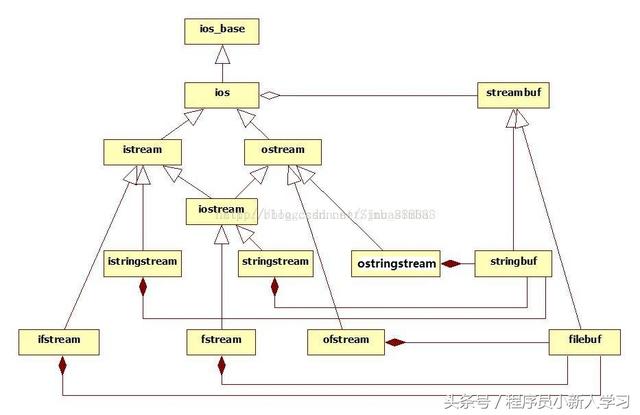一、IO、流
數據的輸入和輸出(input/output簡寫為I/O)
對标準輸入設備和标準輸出設備的輸入輸出簡稱為标準I/O
對在外存磁盤上文件的輸入輸出簡稱為文件I/O
對内存中指定的字符串存儲空間的輸入輸出簡稱為串I/O
數據輸入輸出的過程,可以形象地看成流
從流中獲取數據的操作稱為“提取”(輸入)操作
向流中添加數據的操作稱為“插入”(輸出)操作
标準輸入輸出流
文件流
字符串流
二、流類庫繼承體系、四個輸入輸出對象
流庫具有兩個平行的基類:streambuf 和 ios 類,所有流類均以兩者之一作為基類
streambuf 類提供對緩沖區的低級操作:設置緩沖區、對緩沖區指針操作區存/取字符
ios_base、ios 類記錄流狀态,支持對streambuf 的緩沖區輸入/輸出的格式化或非格式化轉換
stringbuf:使用串保存字符序列。擴展 streambuf 在緩沖區提取和插入的管理
filebuf:使用文件保存字符序列。包括打開文件;讀/寫、查找字符
如下圖:

C 為用戶進行标準I/O操作定義了四個類對象: cin,cout,cerr和clog
cin為istream流類的對象,代表标準輸入設備鍵盤,後三個為ostream流類的對象
cout代表标準輸出設備顯示器
cerr和clog含義相同,均代表錯誤信息輸出設備顯示器
三、ostream流 的操作,istream 流的操作
(一)、ostream流 的操作:
1、operator <<
<<操作返回一個ostream對象的引用,所以可以連續使用
2、put( )
輸出單個字符
返回一個ostream對象的引用
cout.put(‘H’).put(‘i’);
3、write( )
write(buf, len)
write( )返回一個ostream對象的引用
cout.write (buf, len) //char buf[len]
C Code
1
2
3
4
5
6
7
8
9
10
11
12
13
14
15
16
17
18
19
20
#include <iostream>
using namespace std;
int main(void)
{
int n = 100;
int n2 = 200;
cout << n << " " << n2 << endl;
cout.put('H');
cout.put('i');
cout.put(' ');
cout.put('H').put('i').put('\n');
char buf[] = "test!!!!!";
cout.write(buf, 5);
return 0;
}
(二)、istream流 的操作:
1、opeartor>>操作
<<操作返回一個ostream對象的引用,所以可以連續使用
2、get( )
get( )操作:
讀取單個字符
返回一個整數
字符的ASCII碼
get(char&)操作:
讀取單個字符
返回一個istream對象的引用
3、getline( )
讀取一行
遇到回車鍵
返回istream對象的引用
getline()操作與>>的區别:
char string1 [256],
cin.getline(string1, 256); //get a whole line, 以'\0'結尾
cin >> string1; //stop at the 1st blank space
4、read( )
read(buf, len)
返回一個istream對象的引用
對空白字符(包括'\n')照讀不誤
5、peek( ) 與 putpack()
peek:查看而不讀取
putback:将一個字符添加到流
C Code
1
2
3
4
5
6
7
8
9
10
11
12
13
14
15
16
17
18
19
20
21
22
23
24
25
26
27
28
29
30
31
32
33
34
35
36
37
38
39
40
41
42
43
44
#include <iostream>
using namespace std;
int main(void)
{
//int n;
//char ch;
//cin>>n>>ch;
//cout<<"n="<<n<<" "<<"ch="<<ch<<endl;
//int ch = cin.get();
//cout<<ch<<endl;
//char ch1;
//char ch2;
//cin.get(ch1).get(ch2);
//cout<<ch1<<" "<<ch2<<endl;
char buf[10] = {0};
cin.getline(buf, 10);
cout << buf << endl;
//char buf[10] = {0};
//cin>>buf;
//cout<<buf<<endl;
//char buf[10] = {0};
//cin.read(buf, 5);
//cout<<buf<<endl;
/*char c[10], c2, c3;
c2 = cin.get( );
c3 = cin.get( );
cin.putback( c2 );
cin.getline( &c[0], 10);
cout << c << endl;*/
return 0;
}
二、字符串流的基本操作
istringstream,由istream派生而來,提供讀string的功能
ostringstream,由ostream派生而來,提供寫string的功能
stringstream,由iostream派生而來,提供讀寫string的功能
(一)、分割單詞
C Code
1
2
3
4
5
6
7
8
9
10
11
12
13
14
15
16
17
18
19
20
#include <iostream>
#include <sstream>
using namespace std;
int main(void)
{
string line;
string word;
while (getline(cin, line))
{
istringstream iss(line);
while (iss >> word)
cout << word << "#";
cout << endl;
}
return 0;
}
(二)、字符串與double 類型互相轉換
C Code
1
2
3
4
5
6
7
8
9
10
11
12
13
14
15
16
17
18
19
20
21
22
23
24
25
26
27
28
29
30
31
32
33
34
#include <iostream>
#include <sstream>
using namespace std;
string doubletostr(double val)
{
ostringstream oss;
oss << val;
return oss.str(); // return string copy of character array
}
double strtodouble(const string &str)
{
istringstream iss(str);
double val;
iss >> val;
return val;
}
int main(void)
{
double val = 55.55;
string str = doubletostr(val);
cout << str << endl;
str = "123.123";
val = strtodouble(str);
cout << val << endl;
return 0;
}
(三)、實現類似sscanf, sprinft 的功能
C Code
1
2
3
4
5
6
7
8
9
10
11
12
13
14
15
16
17
18
19
20
21
22
23
24
25
26
27
28
29
30
31
32
33
34
35
36
37
38
39
40
41
42
43
44
#include <iostream>
#include <sstream>
using namespace std;
int main(void)
{
//192,168,0,100;
//sscanf,sprintf;
//istringstream iss("192,168,0,100");
//int v1;
//int v2;
//int v3;
//int v4;
//char ch;
//iss>>v1>>ch>>v2>>ch>>v3>>ch>>v4;
//ch = '.';
//ostringstream oss;
//oss<<v1<<ch<<v2<<ch<<v3<<ch<<v4;
//cout<<oss.str()<<endl;
string buf("192,168,0,100");
stringstream ss(buf);
int v1;
int v2;
int v3;
int v4;
char ch;
ss >> v1 >> ch >> v2 >> ch >> v3 >> ch >> v4;
ch = '.';
stringstream ss2;
ss2 << v1 << ch << v2 << ch << v3 << ch << v4;
cout << ss2.str() << endl;
return 0;
}
輸出為192.168.0.100
,更多精彩资讯请关注tft每日頭條,我们将持续为您更新最新资讯!